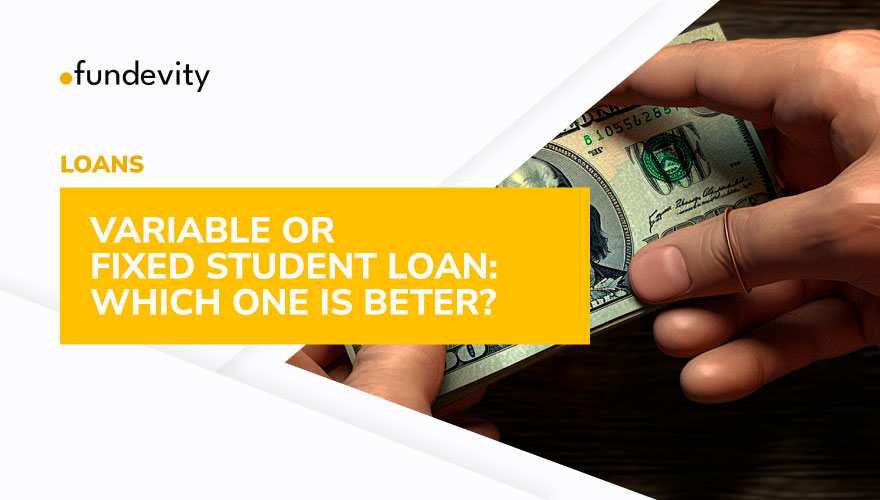Choosing Between Variable or Fixed Student Loan: What You Need to Know?

When it comes to student debts, the rate you obtain is just as crucial as the rate. Preset rates stay constant over the duration of the debt, ensuring consistent regular settlements. Variable rates, in contrast, are susceptible to market alterations. Your regular settlements may fluctuate as a result of this.
There is no universal solution. Preset-rate and variable-rate student debts both have upsides and downsides. When contemplating between them, keep in mind the probability of rate alterations and the dangers affiliated with them, in addition to the effect on your regular settlement. Here’s what you should know about fixed-vs. variable-rate debts, as well as some things to think about when picking which is ideal for you.
How Do Variable Student Loans Work?
Student debts with variable rates are structured in a way that largely affects their rates. Variable rates are only applicable to private student debts. A preset rate applies to all federal student debts.
A variable rate indicates that the rate you incur on the balance of your bill can and frequently might alter further. Your regular settlement may fluctuate if your rate increases.
Your creditor, in contrast, cannot just boost rates anytime it wants to extract more resources from you—conversely, present rates in the monetary sector drive rate changes.
Given the probability of variable rates hiking, you might be questioning why anyone would pick a variable rate over a preset rate. Variable rates begin cheaper than preset rates (though in a few cases, they can be costly).
Advantages of Variable Student Loans
- An affordable rate is possible. Variable rates are normally less expensive than preset rates, especially at the beginning of the reimbursement timeframe.
- You could raise your principal settlement. Because the additional funds will be applied to the principal rather than just the interest charges, doing this can help you settle your debt more quickly.
- You might possibly save even more resources. Due to the probability of obtaining a cheaper rate, variable-rate debts may result in financial savings over the course of your reimbursement tenure.
Disadvantages of Variable Student Loans
- It’s possible that your rate will rise. Although variable student debt rates possess the ability to give some of the lowest rates upfront, there is no assurance that they will remain that way.
- Your regular settlement may go up. With variable-rate debts, rates fluctuate. As a result, if rates rise, your regular settlement may increase.
- You have no way of knowing how much you owe. It’s impossible to determine the complete cost of your student debt reimbursement amount because your rate could alter at any time.
How Do Fixed Student Loans Work?
Preset rates remain unaltered during the debt term, ensuring that your regular student debt settlements remain consistent while you settle your bill. A preset rate can only be changed by refinancing the debt.
Preset rates are normally greater than the cheapest advertised variable rates, but they offer stability because the settlement will not vary. You’ll be aware of how much you’ll incur each month and how much interest you’ll incur in full when you start repaying your student debts.
Preset rates are beneficial to debtors who do not have much wriggle room to accommodate for an altering rate. All new federal student debts possess preset rates, and private servicers normally grant preset rates as well.
Advantages of Fixed Student Loans
- Your regular settlement stays unaltered. Picking a preset-rate debt ensures that your regular settlement keeps being consistent, making it easier to budget for.
- Your rate stays constant. Your rate might not adjust during the debt’s reimbursement timeframe if it has a preset rate. Rate increases and economic uncertainty won’t be an issue for you.
- You know how much you owe. Since the rate and sum due are constant each month, you may quickly determine how much you owe simply by dividing your regular reimbursement by the number of months still remaining in your repayment plan.
Disadvantages of Fixed Student Loans
- Occasionally, variable-rate debts may possess rates that exceed those of your debt. Since the initial rate is greater for preset-rate debts than for variable-rate debts, they frequently hold costly rates.
- You can’t profit from market alterations. Due to the fact that preset rates never alter, you cannot benefit from cheaper rates, which would result in smaller regular settlements. Your sole option for finding a new rate is to refinance your student debts.
- You can end up incurring more. You would be compelled to incur further interest throughout the timeframe of the debt due to the probability that preset-rate debts would impose costly rates.
Variable or Fixed Student Loan: Which One Is Better?
When contemplating between variable and preset-rate student debts, assess your priorities, such as how soon you anticipate repaying the debt, how well you can tolerate the probability of a rate hike, and how the regular settlement sum fits into your capability.
Make sure to receive quotations from a few different student debt providers, regardless of whatever form of student debt you decide to take out. This will help you pay as little interest as feasible.


